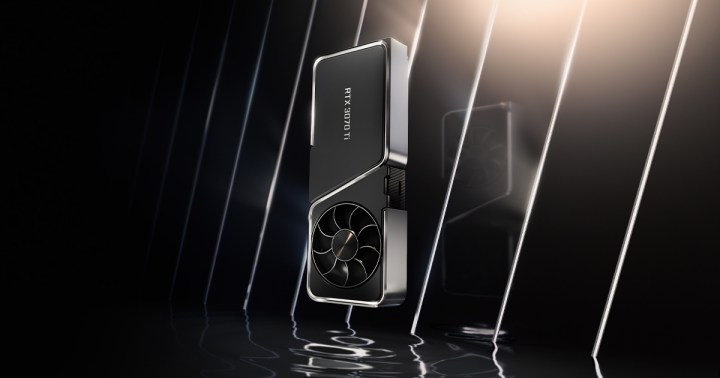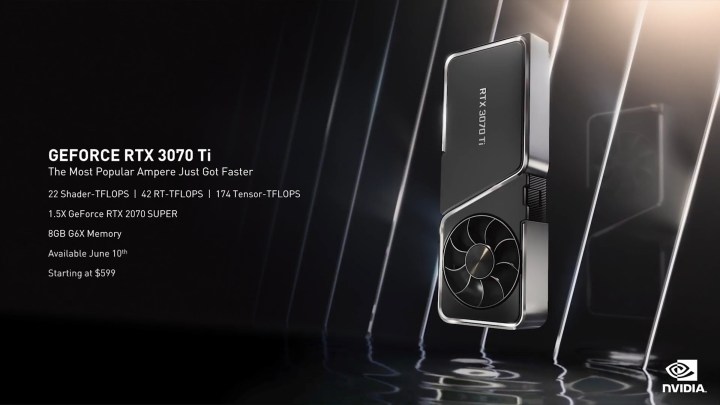
The new Nvidia GeForce RTX 3070 Ti is set to release on June 10. As this graphics card is the successor to the RTX 3070, it has been the subject of a lot of speculation as to how much better the Ti model is going to be. Thanks to benchmark leaks on the Chinese video portal Bilibili, we now have a better idea of the future performance of the RTX 3070 Ti. Compared to its predecessor, the new card has shown quite a lot of promise in testing.
Two benchmark results have leaked, each coming from different sources and pertaining to different models of the card. The source of the first leak is the Chinese Doge Guy (TecLab), who tested the Gigabyte GeForce RTX 3070 Ti Gaming OC. It seems that the exact model of the GPU was not meant to be revealed, but some Gigabyte labels slipped past and show up in the video. This is a card that comes with a custom PCB design with a 10+2 phase VRM (voltage regulator module). It runs on dual eight-pin power connectors and comes with a single HDMI port and three DisplayPort connectors. In order to showcase the PCB, the cooler was removed in the leaked video.

Gigabyte’s RTX 3070 Ti Gaming OC had been tested in both gaming and synthetic benchmarks. The results were then compared to the basic RTX 3070 and to an RTX 3080. When tested against its predecessor, the RTX 3070 Ti shows an increase in performance measuring at around 10%. This boost in frame rates is to be expected and is comparable to the difference between the Nvidia GeForce RTX 3080 and RTX 3080 Ti cards, the latter of which released last week.
Compared to an RTX 3070, the RTX 3070 Ti has faster GDDR6X memory modules. Tests show that the TDP of the card has gone up compared to the previous model, now requiring up to 325W on full power. The cooling system seems to do its job, keeping the GPU at a peak temperature of 60 degrees Celsius.
The second leak comes from a Bilibili leaker known as Big Hardware Player. The card in question was made by the Chinese brand Colorful, a manufacturer known for producing premium, custom GPUs. This time, a GeForce RTX 3070 Ti Vulcan-X was tested not only in games and synthetic benchmarks but also in cryptocurrency mining.

Mining Ethereum is exactly what this GPU is not meant to shine at, as Nvidia attempted to prevent the card from being sniped by crypto miners by implementing the Lite Hash Rate limiter. Due to this feature, the mining performance drops down to half speed shortly into testing. The card returns at most 45 MH/s when overclocked and, much like the first model, showed an increase in gaming performance of around 10%.
Nvidia’s new GeForce RTX 3070 Ti will feature 4% more CUDA cores than its predecessor. On the other hand, compared to the RTX 3080, this card has around 30% fewer cores. This is combined with a base clock speed of 1,580 MHz and 1,770 MHz when overclocked. The default models will feature 8GB of GDDR6X memory, and all the cards are said to maintain a 256-bit memory BUS interface.
This latest release from Nvidia is a welcome sight but will likely sell out quickly. Set to hit the market on June 10, the RTX 3070 Ti is going to come with a $599 starting price — and a whole lot of people looking to buy it.
Editors' Recommendations
- The war between PC and console is about to heat up again
- Don’t buy the RTX 3060 in 2024
- The RTX 5090 and 5080 may launch sooner than expected
- 5 GPUs you should buy instead of the RTX 4070
- Nvidia DLSS is amazing, but only if you use it the right way





